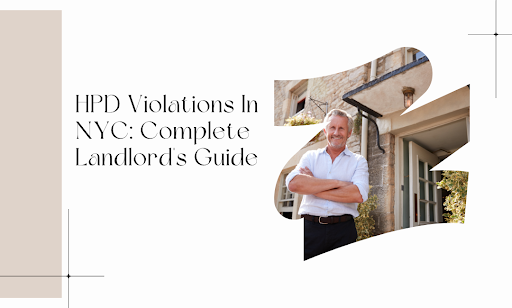HPD violations hit harder than most expect. One notice can escalate into penalties, repair orders, and mounting legal trouble before you’ve had a chance to react. The real problem? Most people don’t fully understand what triggers these violations—or how to respond before costs spiral out of control.
This guide fixes that. In clear, practical terms, it breaks down everything you need to know about HPD violations in NYC—what they are, why they happen, and how to stay ahead of them. Here’s what we’ll cover:
- What HPD actually does in NYC
- The different types of HPD violations and what triggers them
- How penalties stack up if violations go unresolved
- Steps to respond effectively when notices land
- Strategies to prevent repeat violations and reduce risk
- Tools and resources to keep properties compliant year-round
By the end, you’ll know exactly how to handle HPD violations—and more importantly, how to avoid them in the first place.
What HPD Actually Does in NYC
The New York City Department of Housing Preservation and Development (HPD) oversees building conditions across the five boroughs. Its role extends far beyond issuing violations. At its core, HPD enforces housing codes, ensures tenant safety, and maintains building standards that keep properties livable and legally compliant.
To give you a clearer picture, here’s what HPD typically handles:
- Housing Code Enforcement – Inspects and enforces standards for heat, hot water, lead paint, pests, and general habitability.
- Violation Issuance and Tracking – Identifies unsafe or non-compliant conditions and assigns violation categories based on severity.
- Emergency Repairs – Steps to make repairs when landlords fail to correct hazardous conditions, billing the costs back to the owner.
- Tenant Complaint Response – Investigates complaints submitted through 311 or other city channels.
- Property Registration Oversight – Manages annual property registrations to ensure accurate owner and management information.
- Public Data Access – Maintains online records of violations, complaints, and property registration data for transparency.
By regulating these areas, HPD sets the framework for safer buildings and fewer disputes between property owners and tenants.
The Different Types of HPD Violations and What Triggers Them
HPD classifies violations by severity, each carrying its own response timeframes and enforcement measures. Understanding these categories helps property owners act quickly and avoid penalties.
Class A – Non-Hazardous Violations
Class A issues cover basic maintenance or administrative matters that do not present immediate safety risks. Owners usually have more time to correct these conditions.
Examples include:
- Missing window guards in non-family-occupied apartments
- Minor leaks not affecting structural safety
- Outdated property registration details
Class B – Hazardous Violations
Class B violations involve conditions that could threaten tenant health or building safety if left unresolved. These require faster response times compared to Class A.
Examples include:
- Broken entry door locks
- Lack of adequate lighting in hallways or staircases
- Structural cracks pose a moderate risk
Class C – Immediately Hazardous Violations
Class C violations demand immediate correction. These conditions pose direct risks to tenant safety or building integrity, triggering aggressive enforcement measures if ignored.
Examples include:
- No heat or hot water during winter
- Severe lead paint hazards in occupied units
- Fire safety system failures, such as missing sprinklers or alarms
Triggers for HPD Violations
Most violations arise from:
- Tenant complaints filed through 311 or directly to HPD
- Routine HPD inspections for property compliance
- Emergency inspections following accidents or reported hazards
Most violations arise from tenant complaints filed through 311 or directly to HPD, routine HPD inspections for property compliance, or emergency inspections following accidents or reported hazards.
How Penalties Stack Up If Violations Go Unresolved

Unresolved HPD violations rarely stay static. As time passes, the financial and legal consequences grow quickly, creating unnecessary risk for property owners.
- Escalation of Fines: When correction deadlines expire, HPD begins issuing civil penalties. These fines often increase with each day the violation remains open. Minor issues may start with low penalties, but hazardous or immediately hazardous conditions can lead to steep daily charges until corrections are made.
- Emergency Repair Charges: For severe violations, HPD may step in to perform emergency repairs. The cost of labor, materials, and administrative fees is then billed directly to the property owner. Failure to pay these charges can result in liens placed against the building.
- Legal and Administrative Actions: Continued non-compliance can trigger court appearances or administrative hearings. Owners may face additional penalties, legal expenses, and in some cases, restrictions on property use or permits until full compliance is achieved.
- Long-Term Financial Impact: Beyond immediate fines, unresolved violations can lower property value, complicate refinancing, or deter potential buyers and tenants. The longer issues remain unaddressed, the more expensive and complex the resolution becomes.
Steps to Respond Effectively When Notices Land
Speed and structure decide cost, risk, and downtime. Treat each notice like a mini-project with clear ownership, artifacts, and deadlines.
Triage and deadline mapping
Confirm the violation class, the cited code section, and the correction window. Log each deadline on a calendar and assign a single owner for follow-through.
- Map Class C items for same-day action.
- Slot Class B items into the near-term work queue.
- Schedule Class A items with firm target dates to prevent drift.
Verify registration and contact data
HPD relies on current property registration to route notices and schedule inspectors. Validate owner, agent, and site contact details before you take the next step.
- Update registration if names, phones, or mailing addresses have changed.
- Confirm access instructions so re-inspections do not fail.
Scope the condition with evidence
Capture the exact condition cited in the notice. Precise documentation speeds sign-off and prevents repeat findings.
- Time-stamped photos and short videos from multiple angles.
- A brief field note describing location, units, and affected systems.
- For moisture, gas, or electrical issues, add instrument readings where applicable.
Engage qualified trades
Pick the right license class and specialist for the cited issue. Unqualified work triggers repeat violations and failed re-inspections.
- Heating and hot water: licensed boiler or burner tech.
- Electrical hazards: licensed electrician with signed test reports.
- Lead paint hazards: EPA RRP-certified firm with clearance testing by a third party.
- Egress, doors, locks, and self-closing assemblies: technician with code familiarity for multi-family housing.
Secure permits and safe work practices
Check if the correction requires a permit or controlled work method. Health, fire, and structural items carry additional rules.
- Pull necessary permits before demolition or system work.
- Use containment, HEPA filtration, and occupant protection where dust or lead may spread.
- Lockout-tagout for electrical and gas work; document it with photos.
Execute repairs with pass-fail criteria
Write a simple pass-fail checklist for the crew so work aligns with inspection points.
- List exact measurements or performance targets (e.g., door closer timing, pressure, temperature).
- Add acceptance photos that match the inspection view.
Assemble the certification packet
Close-out moves faster when your packet reads like a clean audit trail.
- Before and after photos labeled by location.
- Invoices, technician licenses, and permits.
- Test results or clearance reports were required.
- A brief attestation describing what changed and where.
Submit correction and track status
File through the correct HPD channel for the violation type. Log submission timestamps and confirmation numbers.
- Attach the full packet in one indexed PDF if the portal allows.
- Record the submission in your tracker with the owner’s sign-off.
Prepare for re-inspection
Treat re-inspection as a controlled event. Access, documentation, and operational checks matter.
- Confirm access with tenants and site staff.
- Stage the space: lighting on, panels accessible, and mechanical rooms clear.
- Keep the packet on hand for the inspector.
Manage penalties, liens, and ERP bills
Unresolved items can trigger emergency repair billing, liens, or added civil penalties. Track balances and dispute windows.
- Reconcile posted charges against work already completed.
- Pay or contest within the stated window to avoid compounding fees.
Quick execution matrix
| Phase | Owner action | Key artifacts | Common pitfalls |
| Triage | Log class, code, deadline | Calendar entry, assign owner | Missed dates from vague ownership |
| Evidence | Document condition | Photos, notes, readings | Photos without context or locations |
| Trades | Hire qualified pros | Licenses, scope, estimate | Using unlicensed labor |
| Work | Correct to inspection points | Pass-fail checklist | Partial fixes that miss code intent |
| Certify | File complete packet | Photos, invoices, permits | Fragmented uploads, missing proofs |
| Re-inspect | Control the visit | Access plan, packet on site | No access or blocked equipment |
| Closeout | Clear penalties and bills | Receipts, confirmations | Ignored ERP charges, leading to liens |
Practical checklist for the first 24 hours
- Log the violation in your tracker with class and deadline.
- Call or message the assigned owner with next actions.
- Capture baseline photos and a short video.
- Book the right licensed trade.
- Draft the pass-fail checklist from the cited code section.
- Start the certification packet and keep adding artifacts as you work.
Strategies to Prevent Repeat Violations and Reduce Risk
Avoiding recurring violations requires more than fixing problems as they arise. A long-term, systematic approach keeps buildings compliant and reduces financial exposure.
Build a Preventive Maintenance Schedule
Routine inspections identify small issues before they escalate into violations. A structured calendar ensures critical systems receive attention on time.
- Heating, hot water, and fire safety systems should be checked seasonally.
- Pest control, lead paint assessments, and plumbing maintenance need quarterly review cycles.
- Roofs, exterior walls, and common areas require annual inspections for structural safety.
Document findings after each inspection and track them against correction dates to avoid missed deadlines.
Standardize Documentation Practices
Incomplete or missing paperwork often causes delays in violation clearance. Centralized storage keeps all permits, inspection reports, and contractor certifications accessible.
- Use a shared platform for digital storage rather than relying on paper files.
- Assign responsibility for uploading and reviewing documentation after every repair or inspection.
Train On-Site Staff on Compliance Protocols
Superintendents, maintenance crews, and property managers must understand HPD requirements and reporting procedures. Training reduces response times when violations occur.
- Provide staff with quick reference guides for common violation types.
- Conduct periodic workshops on emergency response protocols and inspection readiness.
Implement Internal Violation Tracking Systems
Tracking tools provide visibility into open, corrected, and recurring issues across multiple properties. These systems help prioritize risk areas and prevent overlooked deadlines.
- Use color-coded dashboards for violation status.
- Set automated reminders for correction deadlines and re-inspections.
Coordinate with Licensed Professionals
Working with qualified trades from the start prevents repeat findings and failed re-inspections. Partner with vendors who understand NYC building codes and HPD requirements.
- Maintain a vetted list of contractors for specialized systems like boilers, fire alarms, and lead abatement.
- Require completion certificates for all work to confirm compliance standards are met.
Conduct Post-Resolution Audits
After violations close, a brief audit verifies that corrective work meets code requirements and remains functional over time.
- Schedule follow-up checks 30–60 days after resolution.
- Record findings in the maintenance log to detect recurring patterns early.
Tools and Resources to Keep Properties Compliant Year-Round

Several tools exist in NYC to help landlords manage compliance, but one stands out for its precision and simplicity: ViolationWatch. It offers a single, unified platform for monitoring, managing, and responding to open violations across HPD and other agencies.
Unlike generic tools or manual methods, this platform integrates every key step into a streamlined process. That means no wasted time switching between portals, chasing reissuance notice paperwork, or paying extra inspection fees due to missed deadlines.
How ViolationWatch Operates for HPD Violations
The platform manages HPD violations in four simple, professional steps:
- Add Your Properties
Landlords enter each property address and apartment number into a secure, centralized dashboard. - Automated Violation Monitoring
The system continuously scans city databases for lead violations, lead-based paint violations, hot water violations, and other certain violations under local law and housing court orders. - Instant Notifications
Alerts go out through WhatsApp, email, and dashboard updates the moment reissued violations post or new certification requirements approach. - Action Before Escalation
With real-time updates and detailed information on every water leak, entrance door, smoke detector, or plumbing fixtures issue, owners can act fast to comply before fines escalate or the emergency repair program intervenes.
Why This Tool Sets You Apart
Running NYC properties means managing compliance risk with the same precision used in financial audits or construction planning. ViolationWatch shifts compliance from reactive to predictive—making your operations look like they were built for regulatory excellence.
Here’s how it changes the game at a technical level:
Compliance Risk Reduction at Scale
Most landlords rely on fragmented methods—manual DOB checks, spreadsheets, and missed email alerts. ViolationWatch consolidates every open violations feed into a single monitoring system. This reduces:
- Error Rates: Automated scanning removes human oversight delays that cause missed deadlines.
- Response Lag: Alerts trigger instantly when violations appear, giving every managing agent or person designated more time to act within the correct time frame.
- Portfolio Blind Spots: Multi-property dashboards reveal recurring problem areas across dozens of private dwelling units in one view.
Operational Efficiency Gains
Time spent tracking violations is time lost managing buildings. ViolationWatch eliminates redundant steps by:
- Automating data pulls from city databases.
- Synchronizing correction deadlines with in-platform calendars for a step-by-step guide to resolution.
- Storing compliance documents for certified violations and reissuance notice filings in a central repository for housing court or re-inspections.
This level of automation cuts administrative hours while ensuring every violation is corrected properly and fully documented.
Financial Risk Containment
Penalties increase exponentially with unresolved violations. By providing real-time visibility into open issues and deadlines, the platform prevents:
- Compounding daily fines for lead-based paint hazards and Class C emergencies.
- Emergency repair program charges are billed back to owners at premium rates.
- Liens that jeopardize refinancing, insurance, or attempts to recover possession through legal proceedings.
Professional Reputation Management
In NYC real estate, reputation determines access to financing, tenants, and permits. Landlords who consistently close violations on time demonstrate operational maturity. ViolationWatch creates:
- Digital audit trails for every correction and request submitted to HPD.
- Timestamped evidence packets for housing court or legal reviews.
- Portfolio-level compliance reports for investors, lenders, and partners.
Failing to use such tools forces landlords back into a reactive posture—where missed violations trigger escalating fines, emergency repairs, or additional certification requirements before properties are cleared for compliance.
Stay Ahead of Housing Preservation and Development (HPD) Violations with Confidence
Managing HPD violations in NYC requires precision, speed, and a system built to eliminate risk at every stage. This guide gave you a clear view of:
- What HPD does across inspections, enforcement, and repairs
- Violation types, triggers, and penalty escalation timelines
- Technical steps to respond effectively when notices arrive
- Preventive strategies to stop repeat violations before they start
- Tools designed to transform compliance from reactive to proactive
The takeaway is straightforward: compliance chaos costs money, time, and reputation. Landlords using structured systems—like ViolationWatch—gain control, reduce penalties, and present a level of operational discipline that investors, lenders, and tenants respect.
Those relying on outdated methods or fragmented tools leave themselves exposed to fines, emergency repair charges, and potential legal disputes. In NYC’s regulatory environment, that is not a sustainable approach.Choosing the right system isn’t about convenience—it’s about running properties like a professional operation, backed by real-time data and automated oversight. That’s how you prevent violations from spiraling into financial and legal setbacks.

